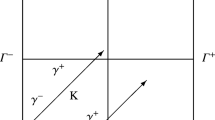Abstract
In this paper we present an error estimate for the explicit Runge-Kutta discontinuous Galerkin method to solve a linear hyperbolic equation in one dimension with discontinuous but piecewise smooth initial data. The discontinuous finite element space is made up of piecewise polynomials of arbitrary degree \(k\ge 1\), and time is advanced by the third order explicit total variation diminishing Runge-Kutta method under the standard CFL temporal-spatial condition. The \(L^2(\mathbb R \backslash \mathcal R _T)\)-norm error at the final time \(T\) is optimal in both space and time, where \(\mathcal R _T\) is the pollution region due to the initial discontinuity with the width \(\mathcal O (\sqrt{T\beta }h^{1/2}\log (1/h))\). Here \(h\) is the maximum cell length and \(\beta \) is the flowing speed. These results are independent of the time step and hold also for the semi-discrete discontinuous Galerkin method.


Similar content being viewed by others
References
Burman, E., Ern, A., Fernandez, M.A.: Explicit Runge-Kutta schemes and finite elements with symmetric stabilization for first-order linear PDE systems. SIAM. J. Numer. Anal. 48, 2019–2042 (2010)
Ciarlet, P.G.: Finite Element Method for Elliptic Problems. North-Holland, Amsterdam (1978)
Castillo, P., Cockburn, B., Schötzau, D., Schwab, C.: Optimal A priori error estimates for the \(hp\)-version of the local discontinuous Galerkin method for the convection-diffusion problems. Math. Comp. 71, 455–478 (2001)
Cheng, Y.D., Shu, C.-W.: Superconvergence of discontinuous Galerkin and local discontinuous Galerkin schemes for linear hyperbolic and convection-diffusion equations in one space dimension. SIAM. J. Numer. Anal. 47, 4044–4072 (2010)
Cockburn, B.: An introduction to the discontinuous Galerkin method for convection-dominated problems In: B. Cockburn, C. Johnson, C.-W. Shu, E. Tadmor , A. Quarteroni (eds.) Advanced Numerical Approximation of Nonlinear Hyperbolic Equations, Lecture Notes in Math, vol. 1697, pp. 151–268. Springer, Berlin (1998)
Cockburn, B., Guzmán, J.: Error estimates for the Runge-Kutta discontinuous Galerkin method for the transport equation with discontinuous initial data. SIAM. J. Numer. Anal. 46, 1364–1398 (2008)
Cockburn, B., Hou, S., Shu, C.-W.: TVB Runge-Kutta local projection discontinuous Galerkin finite element method for conservation laws IV: The multidimensional case. Math. Comp. 54, 545–581 (1990)
Cockburn, B., Lin, S.-Y., Shu, C.-W.: TVB Runge-Kutta local projection discontinuous Galerkin finite element method for conservation laws III: One dimensional systems. J. Comput. Phys. 84, 90–113 (1989)
Cockburn, B., Shu, C.-W.: TVB Runge-Kutta local projection discontinuous Galerkin finite element method for scalar conservation laws II: General framework. Math. Comp. 52, 411–435 (1989)
Cockburn, B., Shu, C.-W.: The Runge-Kutta local projection \(\mathbb{P}^1\)-discontinuous Galerkin method for scalar conservation laws. RAIRO Modél. Math. Anal. Numér. 25, 337–361 (1991)
Cockburn, B., Shu, C.-W.: The Runge-Kutta discontinuous Galerkin finite element method for conservation laws V: Multidimensional systems. J. Comput. Phys. 141, 199–224 (1998)
Cockburn, B., Shu, C.-W.: Runge-Kutta discontinuous Galerkin methods for convection-dominated problems. J. Sci. Comput. 16, 173–261 (2001)
Hesthaven, J., Warburton, T.: Nodal discontinuous Galerkin methods. Algorithms, analysis, and applications. Springer, Berlin (2008)
Johnson, C., Nävert, U., Pitkäranta, J.: Finite element methods for linear hyperbolic problems. Comput. Method Appl. Mech. Eng. 45, 285–312 (1984)
Johnson, C., Pitkäranta, J.: An analysis of the discontinuous Galerkin method for a scalar hyperbolic equation. Math. Comp. 46, 1–26 (1986)
Johnson, C., Schatz, A., Walhbin, L.: Crosswind swear and pointwise errors in the streamline diffusion finite element methods. Math. Comp. 49, 25–38 (1987)
Reed, W.H., Hill, T.R.: Triangular mesh methods for the neutron transport equation, Los Alamos Scientific Laboratory report LA-UR-73-479. Los Alamos, NM (1973)
Shu, C. -W.: Discontinuous Galerkin methods: general approach and stability, Numerical Solutions of Partial Differential Equations. In: Bertoluzza, S., Falletta, S., Russo, G., Shu, C.-W. (eds.) Advanced Courses in Mathematics CRM Barcelona, pp. 149–201. Birkhäuser, Basel (2009)
Shu, C.-W., Osher, S.: Efficient implementation of essentially non-oscillatory shock capturing schemes. J. Comput. Phys. 77, 439–471 (1988)
Zhang, Q., Shu, C.-W.: Error estimates to smooth solution of Runge-Kutta discontinuous Galerkin methods for scalar conservation laws. SIAM. J. Numer. Anal. 42, 641–666 (2004)
Zhang, Q., Shu, C.-W.: Stability analysis and a priori error estimates to the third order explicit Runge-Kutta discontinuous Galerkin method for scalar conservation laws. SIAM. J. Numer. Anal 48, 1038–1064 (2010)
Author information
Authors and Affiliations
Corresponding author
Additional information
The research of the first author is supported by NSFC grants 10871093 and 11271187, and also supported partially by NSFC grants 10931004 and 11071116. The research of the second author is supported by NSF grant DMS-1112700 and DOE grant DE-FG02-08ER25863.
Appendix
Appendix
1.1 Proof of Lemma 3.3
The second conclusion is obviously the corollary of the first one, so we only prove the first inequality of Lemma 3.3. To that end, we just need to consider this error estimate in a given cell \(I_j\), and then summing this result over all elements.
Since the considered projection \(\mathbb W \) is linear and is exact for any piecewise polynomials \(v_h\), we have \(\mathbb W ^{\bot }(\psi v_h)=\mathbb W ^{\bot }((\psi -c_j) v_h)\), where \(c_j\) is any arbitrary constant. Starting form the general approximation property [3], or the conclusion in Lemma 3.2 (with \(\psi =1\)), we can find a bounding constant \(C>0\) independent of \(j\) and \(v_h\), such that
Taking \(c_j=\psi (x_j)\) and noticing \(\gamma h^{\sigma }\ge h\ge h_j\), then we will have
due to the first inverse property in Lemma 3.1 (with \(\psi =1\) there), and property (3.3b) of the weight function \(\psi (x,t)\).
Next, we multiply the quantity \(\psi ^{-1/2}(x_j)\) in the above inequality. Using property (3.3a) of the weight function gives us that
the sum of which on every cells yields the first conclusion of this lemma.
1.2 Proof of Lemma 3.5
After an integration by parts, we have \(\mathcal H (w,\psi v)= -\sum _j (\beta \psi v, w_x)_j -\sum _j\beta \psi _{j+\frac{1}{2}}[\![w]\!]_{j+\frac{1}{2}}v^{+}_{j+\frac{1}{2}}\). Each term on the right-hand side can be easily estimated by the weighted Cauchy-Schwarz inequality and the inverse properties in Lemma 3.1, which follows
form the simple inequality \((a-b)^2\le 2(a^2+b^2)\), if both \(w\) and \(v\) belong to the finite element space \(V_h\). The final upper boundedness reads \(|\mathcal H (w,\psi v)|\le (1+\sqrt{2})\beta \mu (\nu h)^{-1} \Vert w\Vert _{\psi }\Vert v\Vert _{\psi }\). This completes the proof of this lemma.
1.3 Proof of Lemma 4.1
We can prove every conclusion in this lemma along the same way. First we multiply the test function \(v_h\in V_h\) on both sides of the following three equalities: the definitions (4.4a) and (4.4b), and the equality
which will be proved later. Then we transform the time derivatives into space derivatives with the application of the hyperbolic equation (4.1). Finally, fixing the time at \(t=t^n\) and integration by parts yield the conclusions of this lemma.
Now we prove Eq. (8.5) and complete the proof of this lemma. Using (4.4b) and (4.4a) successively, we will get
where the last equality comes from the Taylor’s expansion in time. Here we have dropped the arguments \((x,t)\) for simplicity of notations.
1.4 Proof of Lemma 5.5
At the first step we take the test function \(v_h=\mathbb Q _h(\psi ^{n}\mathbb D _1\xi ^{n})\) in (5.1a), and obtain the explicit expression
This result has almost the same construction as (5.3). Each term on the right-hand side, denoted respectively by \(Y_1, Y_2\) and \(Y_3\) in order, will be estimated one by one.
The main work in this proof is how to get a sharp estimate to the first term \(Y_1\). To do that, we have to abandon the conclusion in Lemma 3.5, and adopt the decomposition with respect to the generalized slope function \(\mathfrak M (\mathbb D _1\xi ^{n})\).
Note that \(\partial _x(\mathbb D _1\xi ^{n})=\mathfrak M (\mathbb D _1\xi ^{n})(x-x_j)/h_j +\partial _x(\mathfrak M (\mathbb D _1\xi ^{n}))/h_j\) in each cell \(I_j\). Expanding the spatial derivative \(\partial _x(\psi ^{n}\mathbb D _1\xi ^{n})\) in \(\mathcal H (\xi ^{n},\psi ^{n}\mathbb D _1\xi ^{n})\), and applying the weighted Cauchy-Schwarz inequality to each term there, we will obtain the inequality
where we have also used \(|(x-x_j)/h_j|\le 1/2\) and \(h_j^{-1}\le \nu ^{-1}h^{-1}\) in each cell. Since both \(\mathfrak M (\mathbb D _1\xi ^{n})\) and \(\xi ^{n}\) belong to \(V_h\), we use the inverse properties (3.5a) and (3.5b), in Lemma 3.1, to estimate the first and the last terms on the right-hand side of (8.7), respectively. Further, we use property (3.3b) of the weight function to cope with the third term. Together with the application of Young’s inequality, the above process yields
where \(\varepsilon \) is any small positive constant. Hence, Lemma 5.3 about the generalized slope function gives that
By using the superconvergence results given in Lemma 3.3, the weighted Cauchy-Schwarz inequality, and Young’s inequality, we have the estimate to the remaining terms
here \(\gamma h^{\sigma -1}\) is assumed to be large enough such that \(C\gamma ^{-1}h^{1-\sigma }\le 1/6\). Finally we substitute inequalities (8.8) and (8.9) into (8.6), and solve out \(\Vert \mathbb D _1\xi ^{n}\Vert _{\psi ^{n}}^2\). This completes the proof of this lemma.
1.5 Proof of inequality (5.6)
The proof is straightforward by using an integration by parts, and is almost the same as that in [4]. A simple manipulation yields that
where \(\Psi =-(2h_j^2)^{-1}\int _{I_j}\mathfrak M ^2(x)\partial _x\psi (x) (x-x_{j-1/2})(x-x_j)\mathrm d x\). Property (3.3b) of the weight function implies that
if \(\gamma h^{\sigma -1}\) is assumed to be large enough, since \(|2(x-x_{j-1/2})(x-x_j)|\le h_j^2\) in each cell. Thus we have completed the proof of this lemma.
Rights and permissions
About this article
Cite this article
Zhang, Q., Shu, CW. Error estimates for the third order explicit Runge-Kutta discontinuous Galerkin method for a linear hyperbolic equation in one-dimension with discontinuous initial data. Numer. Math. 126, 703–740 (2014). https://doi.org/10.1007/s00211-013-0573-1
Received:
Revised:
Published:
Issue Date:
DOI: https://doi.org/10.1007/s00211-013-0573-1




